Risque
Le rapport « La situation mondiale des transferts monétaires » du CaLP Network indique que l’idée selon laquelle les transferts monétaires seraient plus risqués que d’autres formes d’aide est l’une des barrières principales à l’utilisation fréquente de cette modalité. Ces craintes sont liées à l’insistance de plus en plus franche des bailleurs concernant la lutte contre le terrorisme et contre le blanchiment d’argent, et à l’amenuisement des budgets destinés à l’assistance humanitaire. Le travail du CALP Network sur cette problématique vise à combattre les idées reçues, à faciliter la collaboration et à partager les apprentissages afin de veiller à ce que les transferts monétaires soient systématiquement considérés, tout comme d’autres modalités, en fonction des données probantes disponibles sur les risques réels de toutes les modalités.
Priorités actuelles
Plusieurs organisations travaillent actuellement sur les risques entraînés par les transferts monétaires. Le CALP Network cherche à identifier les synergies entre acteurs, à éviter les duplications et à définir des priorités communes sur lesquelles nous pourrions agir plus efficacement en groupe. Avec le PAM, le CALP Network co-dirige l’élément Risques, priorité du chantier du Grand Bargain sur les transferts monétaires.
Contenu présenté
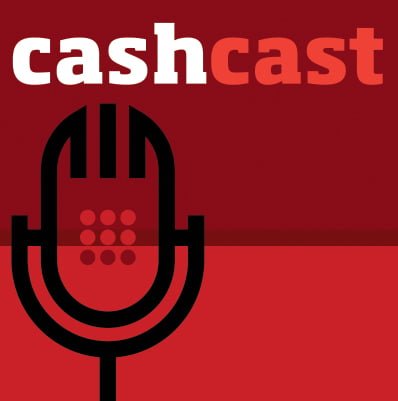
Podcast: Will risk aversion hold us back from realizing the potential of CVA?
Podcast
Episode 1 of the CashCast, exploring how attitudes to risk have impacted the use of CVA in the Middle East and North Africa region.

Transferts monétaires et risques : ce qui se passe sur le terrain, reste sur le terrain (et pourquoi c’est un problème)
Blog Post
En octobre 2019, le CALP Network a facilité à Douala, au Cameroun, une réunion de partage d’expériences sur les risques liés à la protection des bénéficiaires dans les interventions monétaires. Cette réunion restreinte, organisée dans le cadre d’une série de rencontres dans différentes régions, a permis à 25 travailleurs humanitaires d’Afrique de l’Ouest et du Centre,...

Webinar: Data sharing in CVA: ethics, ownership and privacy
Event
Thematic lead
Contenu récent

Cash and Voucher Assistance Guidelines for Lao PDR
Guidelines and Tools
Cash and voucher assistance is becoming increasingly popular in Lao PDR in delivering humanitarian assistance, rehabilitation and development focused projects. In supporting the cash and voucher assistance agenda in Lao PDR, the Cash Working Group was established as a working group for local and regional...

Dossier stratégique du cluster mondial pour l’éducation liste de contrôle sur les transferts monétaires
Guides et outils
La présente liste de contrôle fournit des orientations qui vous aideront à envisager les modalités d’exécution des transferts monétaires tout au long du document de stratégie du Cluster et du processus d’élaboration de celle-ci, de la même façon que pour l’aide en nature. Les transferts...

CVA for Health Outcomes – Position Paper
Policy paper
The RCRCM CVA for Health Outcomes Technical Working Group Position Paper on Cash for Health Outcomes explores how CVA (a form of demand side financing) can be used to support health outcomes, as a complement to supply side interventions, and highlight some of the key considerations.
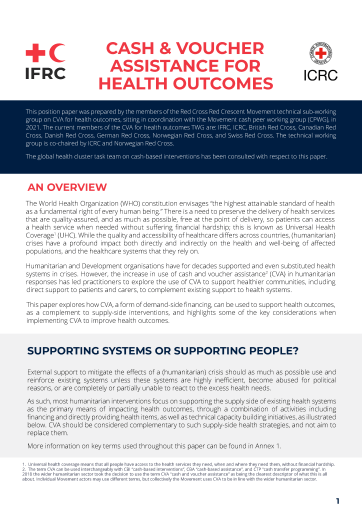
Cash and Voucher Assistance for Health Outcomes
Policy paper
The RCRCM CVA for Health Outcomes Technical Working Group Position Paper on Cash for Health Outcomes explores how CVA (a form of demand side financing) can be used to support health outcomes, as a complement to supply-side interventions, and highlight some of the key considerations.

Safer Cash Toolkit (Français)
Guides et outils
La trousse pour une gestion sûre des espèces a été conçue dans
le but d’apporter une solution au problème de manque de données
pour l’évaluation systématique des risques encourus par les individus
qui reçoivent et utilisent l’assistance en espèces de programmes
humanitaires. Cette trousse...

“Pinning down moving targets”: Adapting humanitarian cash programmes to the multi-pronged crises in Lebanon
Report
Whilst most humanitarian responses across the globe have had to navigate the impact of the Coronavirus pandemic, in Lebanon the challenges related to COVID-19 emerged on top of an unprecedented protest movement, political instability, a rapid deterioration of the economy and the increasingly protracted...

Establishing a Cash Working Group and GBV Sub-Cluster task force: NW Syria Case Study
Report
The case study was created with the inputs of two Cash Working Group leads and the GBV Turkey cross-border Sub-Cluster leads in the Northwest Syria response. The case study demonstrates an example of meaningful linking of gender-based violence response and cash and voucher assistance. As Cash and Voucher...

UNHCR Cash Assistance and COVID-19: Main Findings from Post-Distribution Monitoring
Report
UNHCR is pleased to share the report UNHCR Cash Assistance and COVID – 19: Main Findings from Post-Distribution Monitoring (PDM), which provides a summary and analysis of UNHCR’s monitoring data from 13 countries during the pandemic along with detailed examples from country operations including on...
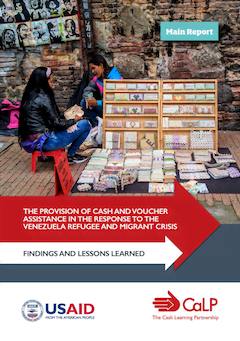
The Provision of Cash and Voucher Assistance in the Response to the Venezuela Refugee and Migrant Crisis: Findings and lessons learned – Main report
Report
This study, for which data was compiled between March and April 2020, seeks to document lessons and good practices in the delivery of CVA in Ecuador and Colombia by humanitarian organisations and governments, in response to migrants and refugees from Venezuela. The purpose of this analysis is...

Cash and Voucher Assistance and Risk: Perception vs Reality Grand Bargain Cash Workstream Annual Virtual Meeting
Webinar
You are invited to a webinar hosted by the CALP Network and WFP under the Grand Bargain cash workstream annual virtual meeting umbrella. Is cash assistance riskier than in-kind? All the evidence says no, but we still act as if it is. Join us for this important conversation diving into the world of CVA and...
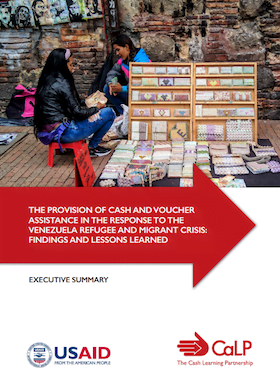
The Provision of Cash and Voucher Assistance in the Response to the Venezuela Refugee and Migrant Crisis: Findings and lessons learned, Executive summary
Report
This study, for which data was compiled between March and April 2020, seeks to document lessons and good practices in the delivery of CVA in Ecuador and Colombia by humanitarian organisations and governments, in response to migrants and refugees from Venezuela. The purpose of this analysis is...

Cash and Voucher Assistance and Risk: Perception vs Reality Grand Bargain Cash Workstream Annual Virtual Meeting
Webinar recording
Webinar hosted by the CALP Network and WFP under the Grand Bargain cash workstream annual virtual meeting umbrella.
Is cash assistance riskier than in-kind? All the evidence says no, but we still act as if it is.
During the Covid-19 pandemic CVA has been the modality of choice in humanitarian responses....

Cash and Voucher Assistance (CVA) and Partnership Toolkit – 10 principles
Guidelines and Tools
This year(2020) has called for a strong reflection on what we mean by partnership and how we work responsibly within CVA programs in support of localizaiton. For example, what do equitable and equal partnerships look like and why they are critical for accountable and quality humanitarian programs? In what...

Cash and Voucher Assistance (CVA) and Partnership Toolkit – Good Practices & Guiding Questions
Guidelines and Tools
This document outlines in detail steps and considerations in Cash and Voucher Assistance (CVA) programs that are supporting of Local Humanitarian Leadership, align with principled and effective partnerships and follow minimum quality standards for partnerships across each phase of the CVA project cycle.

Cash and Voucher Assistance (CVA) and Partnership Toolkit
Guidelines and Tools
This year(2020) has called for a strong reflection on what we mean by partnership and how we work responsibly within CVA programs in support of localizaiton. For example, what do equitable and equal partnerships look like and why they are critical for accountable and quality humanitarian programs? In what...

Presentation for the CALP Network’s webinar on remote registration and verification in the COVID-19 response
Presentation
Watch the webinar recording here Speaker presentations from the CALP Network’s 14 July 2020 webinar on: Peril or pitfalls?: Emerging practices on remote registration and verification in the COVID-19 response Remote CVA programming has been highlighted as a key challenge for the community of practice in...

Review and analysis of identification and registration systems in protracted and recurrent crises
Report
This report presents findings from a study regarding Management and Information Systems (MIS) used to identify and register target populations in cash transfer and social protection programming. The research was conducted by DAI and Caribou Digital, and commissioned through DFID’s BASIC programme. The...
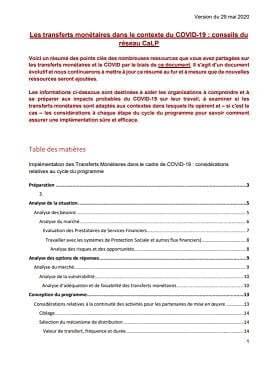
Les transferts monétaires dans le contexte du COVID-19 : conseils du réseau le CALP Network
Guides et outils
Voici un résumé des points clés des nombreuses ressources que vous avez partagées sur les transferts monétaires et le COVID par le biais de ce document. Il s’agit d’un document évolutif et nous continuerons à mettre à jour ce résumé au fur et à mesure que de nouvelles ressources seront...

Webinar | Multi-purpose Cash Transfer and Child Protection: a case study (English and Spanish editions)
Webinar recording
Watch the webinar recording here. More information here. In 2018, with the support of OFDA and FFP, Save the Children implemented a multi-purpose cash transfer ‘Plus’ program in response to the influx of Venezuelan into Colombia. The program aimed at covering vulnerable household’s basic needs and...
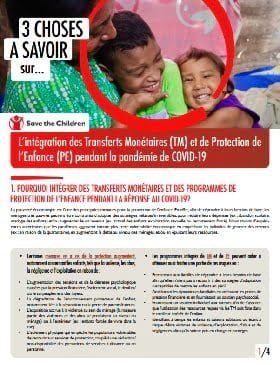
3 Choses à savoir sur…L’intégration des Transferts Monétaires (TM) et de Protection de l’Enfance (PE) pendant la pandémie de COVID-19
Guides et outils
Ce tipsheet interactif de 4 pages vise à résumer pourquoi, quels types et comment intégrer les transferts monétaires (TM) et la protection de l’enfance (PE) pendant le COVID-19. Il se concentre sur les aspects clefs liés à la conception et la mise en œuvre de programmes intégrés et propose des...



